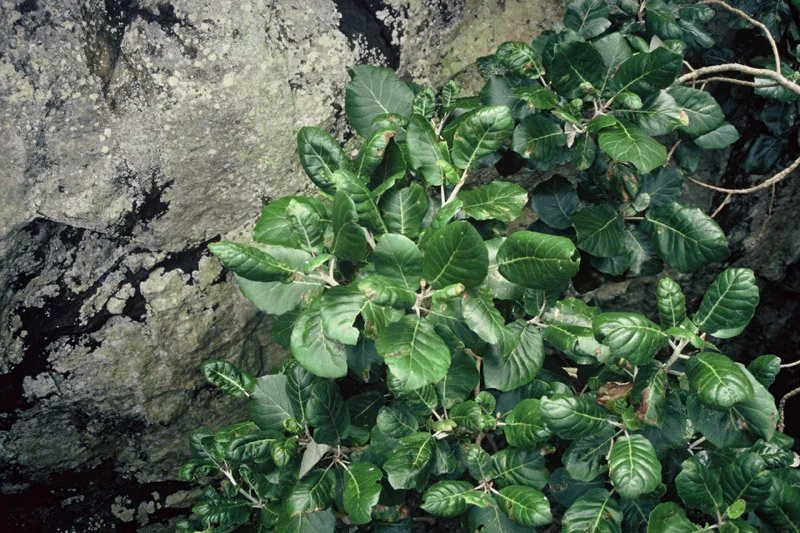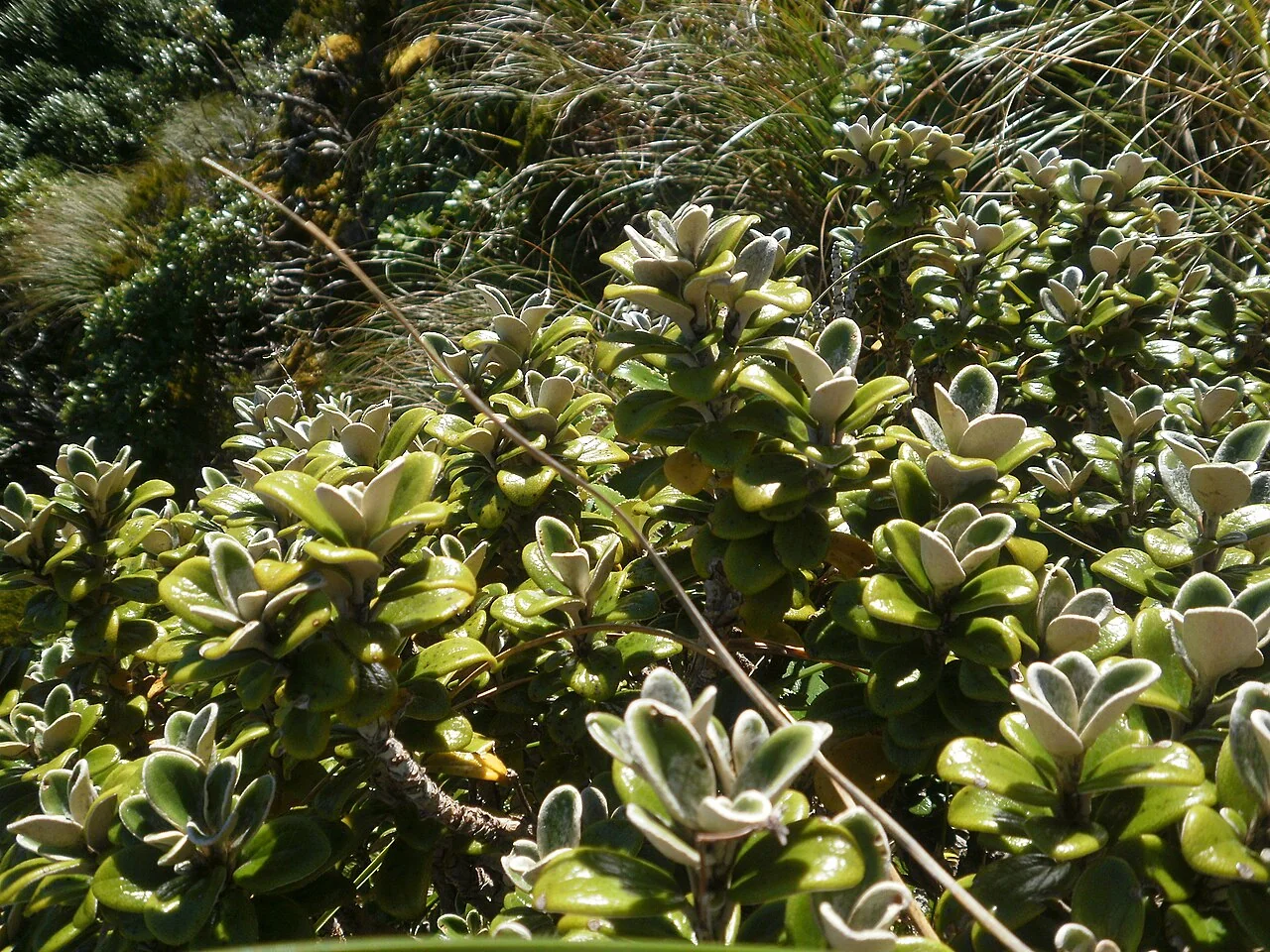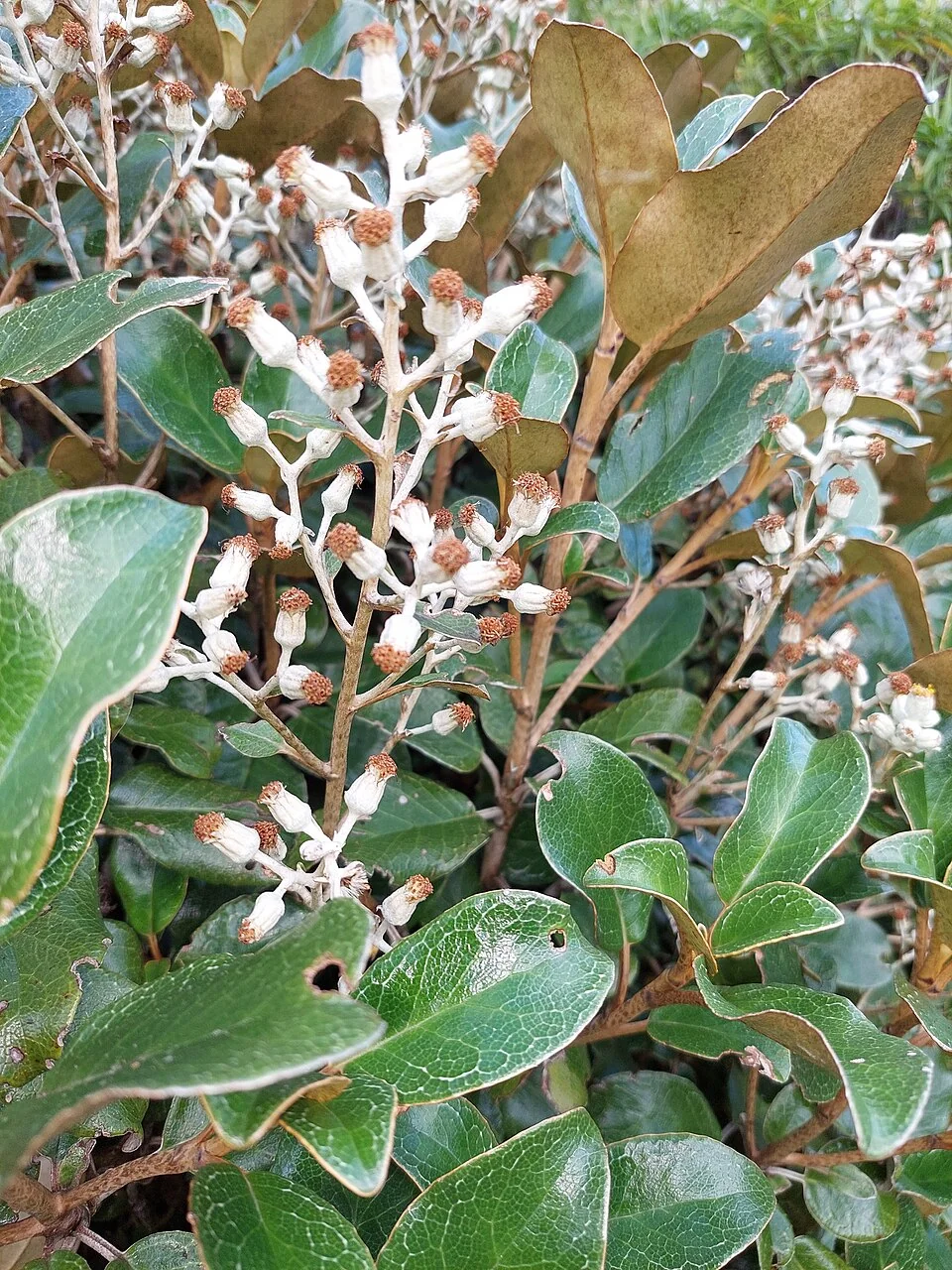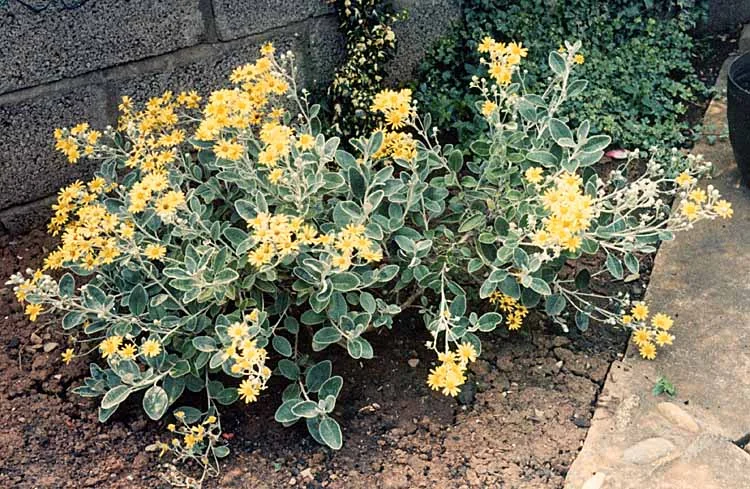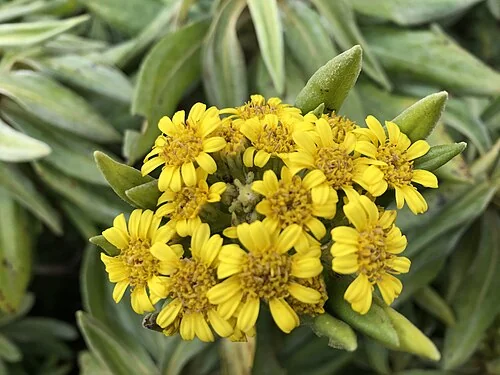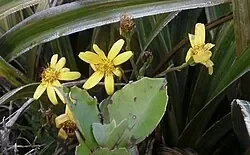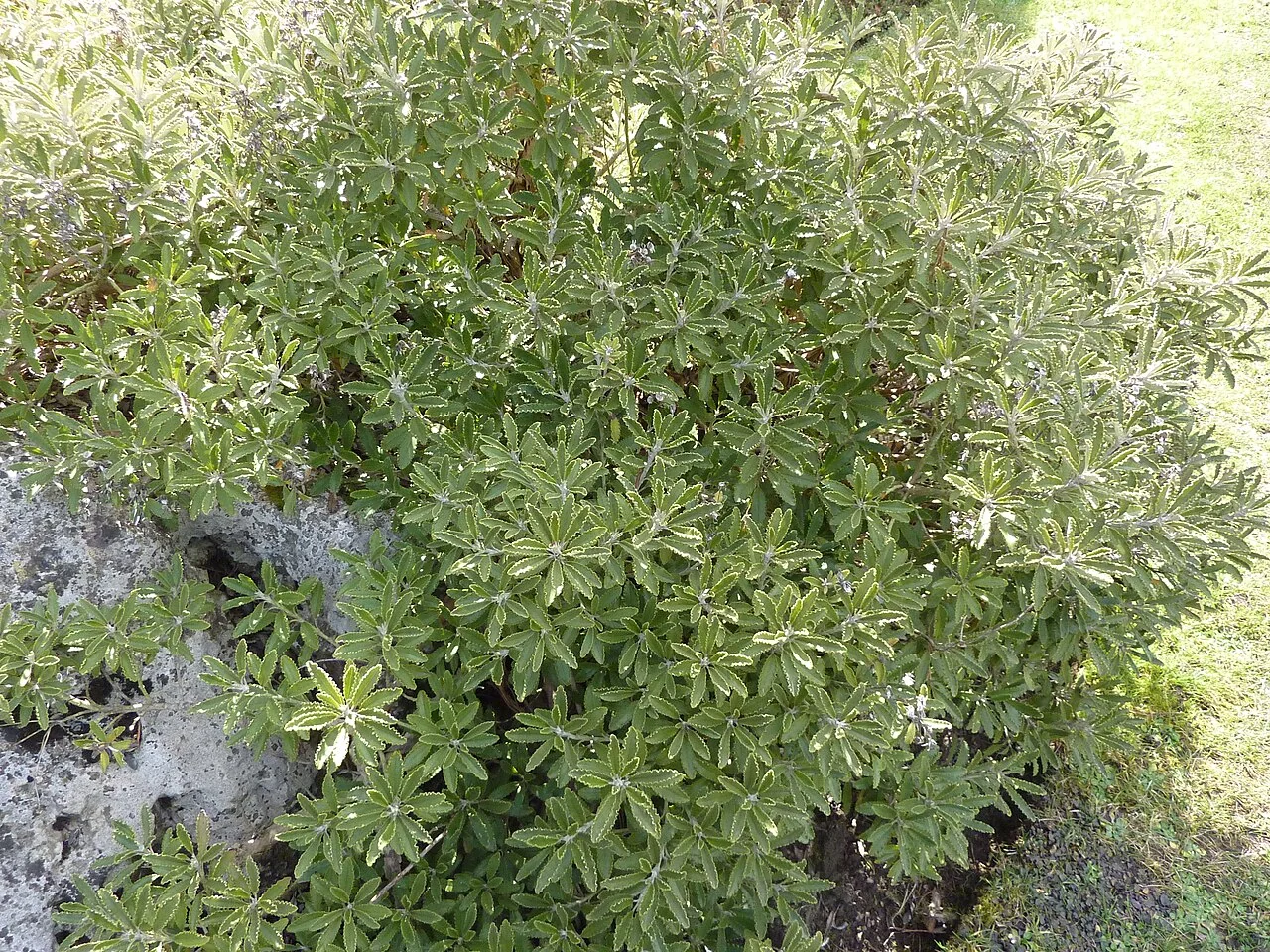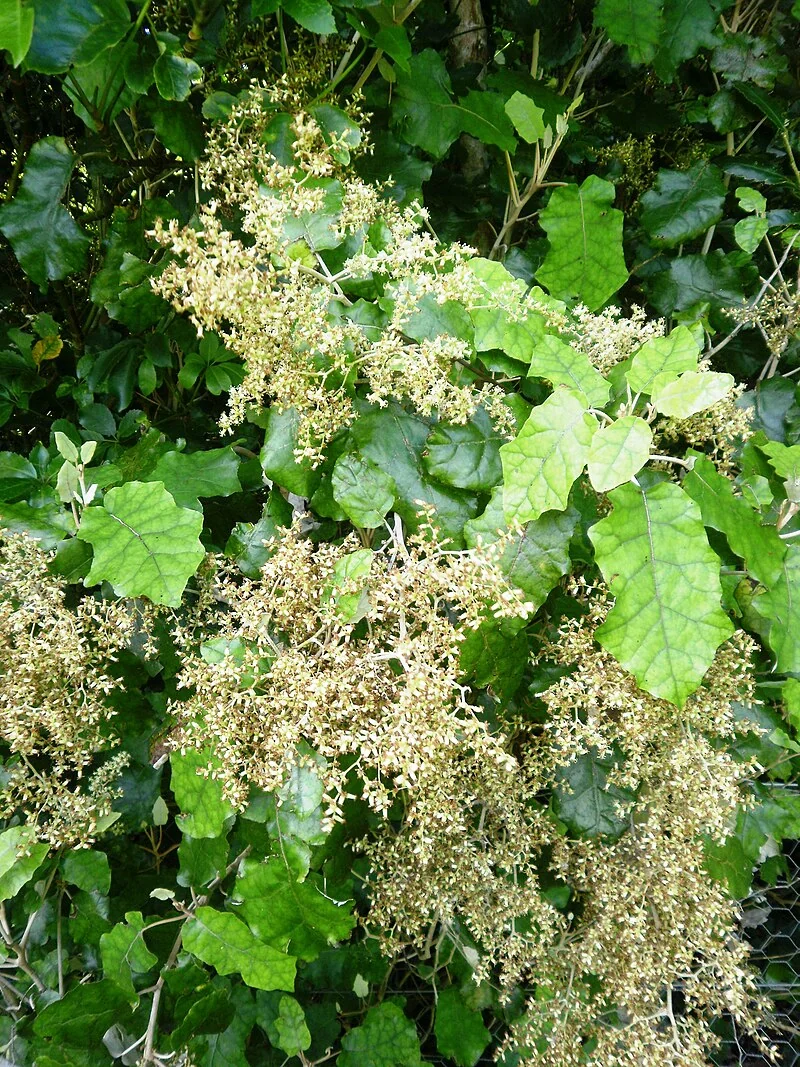
Rangiora
Brachyglottis repanda
Brachyglottis repanda , commonly known as rangiora or bushman's friend, is a shrub or small tree endemic to New Zealand. It typically grows to a height of 5 to 7 meters, though it can reach up to 6 meters or more. The plant has stout, spreading, somewhat brittle branches and a trunk covered in corky bark. Its leaves are large, leathery, and often mottled, ranging from 5-25 cm long and 5-20 cm wide. The upper surface is dark green to pale green, while the underside is covered in fine, vivid white hairs, giving it a distinctive white or silvery appearance. shrubs .

Plant Description
Brachyglottis repanda (rangiora, “bushman’s friend”) is a fast-growing shrub to small tree with very large, soft leaves-green above and felted white beneath-that can exceed 30 cm. Loose clusters of creamy flowers appear in late winter to spring and are followed by wind-borne seed.
Quick Facts
| Scientific Name | Brachyglottis Repanda |
|---|---|
| Common Name | Rangiora, Bushman's friend |
| Plant Type | Shrub or small tree |
| Height | 5-7 meters (up to 6 meters or more) |
| Spread | 3-5 meters |
| Branches | Stout, spreading, somewhat brittle |
| Trunk | Corky bark |
| Leaves | Large, leathery, often mottled, 5-25 cm long, 5-20 cm wide; dark green to pale green above, vivid white hairs underneath; margins dentately lobed to sinuate; petioles 8-10 cm long; new growth tawny or white fuzz |
| Flowers | Small, white or cream, clustered in large, much-branched panicles (Aug-Oct); capitula ~5 mm diameter, 10-12 yellow florets |
| Seeds | Narrowly oblong-elliptic to oblong elliptic, 1-1.8 mm long, 6 rounded ribs, buff-yellow, scabrid pappus 2-3 mm long |
| Habitat | Coastal, lowland, and lower montane shrubland and open forests |
| Distribution | North Island and parts of South Island, New Zealand |
| Pioneer Species | Yes |
| Water Needs | Moderate; prefers moist, well-drained soils |
| Light | Full sun to partial shade |
| Frost Tolerance | Frost-tender; requires protection in cooler areas |
| Salt Tolerance | High; suitable for coastal gardens |
| Growth Rate | Fast |
| Lifespan | Short-lived despite fast growth |
Climate Best Suited to
Thrives in mild, coastal to lowland climates with good rainfall. Young plants are frost-tender; established plants tolerate light frosts. Prefers shelter from strong salt-laden winds but copes with coastal influence.
Regional Suitability
| City | Climate Suitability |
|---|---|
| Whangārei | Ideal |
| Auckland | Ideal |
| Hamilton | Ideal |
| Tauranga | Ideal |
| Rotorua | Ideal |
| Gisborne | Ideal |
| New Plymouth | Ideal |
| Napier | Ideal |
| Whanganui | Ideal |
| Palmerston North | Ideal |
| Wellington | Ideal |
| Nelson | Ideal |
| Christchurch | Ideal |
| Dunedin | Ideal |
| Invercargill | Ideal |
Natural Habitat
Common at forest margins, disturbed scrub and coastal slopes throughout much of Aotearoa, especially on fertile, free-draining soils. A pioneer species after disturbance, quickly forming leafy shelter.
Plant Conservation
Widespread and not threatened. As a resilient pioneer, rangiora readily recolonises slips, road cuttings and windthrows, with seed dispersed effectively by wind and birds. Local pressures include browsing of seedlings by possums and stock, and weed competition on fertile margins. Protection of regenerating shrubland and continued predator control help maintain vigorous, self-sustaining populations across its range.
How to Grow
Planting Guide
Best Planting Practices
Plant young specimens of Brachyglottis repanda after the last frost in spring or in early autumn. Space plants 2-3 meters apart to allow for their mature spread, especially if creating a screen. Stake lightly if planting in an exposed site; prune lightly after flowering to encourage branching and maintain dense, healthy foliage, contributing to a robust plant.
Ecology
Provides early shelter and habitat for invertebrates; flowers support pollinating insects. Leaves are unpalatable to stock and can be toxic if eaten in quantity.
Uses
Rangiora serves as an excellent rapid screen or nurse plant, providing shelter for more delicate species, and offers a bold foliage accent in garden designs. It is highly useful for revegetation projects, especially in disturbed areas, and functions as an effective backdrop in large gardens, creating striking contrast with fine-leaf grasses and divaricating shrubs.
Landscaping Ideas
Rangiora makes a bold statement in the landscape with its large, distinctive foliage. Pair it effectively with silver-foliaged Astelia, textural Chionochloa tussocks, and various Coprosma groundcovers to create dynamic and layered native plantings. Ensure ample space to fully appreciate its leaf size and avoid planting beneath overhead powerlines.
Seasonal Care
Spring
Feed with balanced slow-release fertiliser; tip-prune for bushiness.
Summer
Mulch and water during prolonged dry spells.
Autumn
Light formative prune after flowering.
Winter
Protect young plants from frost; avoid heavy pruning.
Pruning
Pruning Techniques
Tip-prune after flowering to thicken new growth and keep foliage low on the stems. Avoid hard cuts into old, bare wood, as rangiora can be slow to reshoot and branches are naturally brittle. Remove a few entire, crossing limbs to open the canopy, and thin out wind-shattered shoots after storms. Sanitize tools; sap can irritate sensitive skin.
How to Grow Rangiora
Rangiora is a fast-growing pioneer shrub that responds best to free-draining soils, regular water during establishment, and protection from severe wind in its first season. Prioritise siting and soil preparation: choose full sun to light shade, dig generous planting holes, and blend in coarse organic matter to improve structure while keeping the crown slightly elevated so water drains away from the stem base. Water deeply after planting to settle soil around the roots, then mulch with chunky bark or gravel to conserve moisture and suppress weeds without holding water against the trunk. Feed lightly in spring with a balanced, slow-release fertiliser; over-feeding encourages weak, sappy growth that is more wind-tender.
Seed
Sow fresh seed in late winter to spring onto a free-draining seed-raising mix, barely covering with fine grit. Keep evenly moist and in bright light out of direct midday sun. Prick out once seedlings have several true leaves. Seedlings establish rapidly outdoors once the risk of frost has passed and nighttime temperatures are mild.
Cuttings
Take semi-hardwood cuttings from vigorous juvenile shoots in late spring to late summer. Reduce leaf area, treat with a light rooting hormone, and strike in a coarse, free-draining medium under gentle bottom heat and high humidity. Vent progressively as roots develop, then pot on to a moisture-retentive but well-aerated mix. Harden for 2-3 weeks before planting out.
After-Care
Water during dry spells in the first summer, maintain a mulch collar, and tip-prune after flowering to build a dense framework. Avoid heavy cuts into old wood. In windy coastal districts, plan a shelter belt or plant in the lee of sturdier shrubs until Rangiora forms its own wind-break.
Pests and Diseases
Common Problems and Solutions
Generally robust. Occasional caterpillars and leaf miners cause cosmetic damage; manage with hand removal or biological controls. Avoid stock browsing due to toxicity risk.
Cultural Significance
Traditional Uses and Values
The soft, felted leaves gave rangiora its colloquial name “bushman’s friend”, historically used as improvised toilet paper and food wrappers. The plant is a familiar component of coastal forest edges and regenerating scrub in Aotearoa.
Bonus Tip
Expert Growing Advice
For the whitest leaf undersides, which gives Rangiora its distinctive appeal, grow in bright light with shelter from harsh wind. Position it where the silvery undersides can be appreciated, such as along paths or terraces, to fully emphasize the striking contrast and beauty of the foliage.
